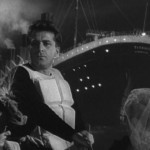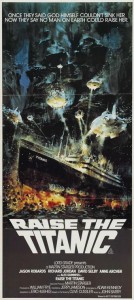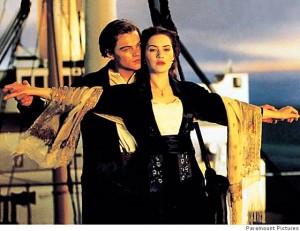 Titanic films have been a consistent staple for over 100 years. Yes, there have been a few. And we are not talking Ben-Hur. We are talking R.M.S. Titanic. There have been several significant attempts over the years to recreate on film and document the sinking of the ill-fated White Star Liner Titanic- and at least in one instance an attempt to raise it. The most popular without fail is the 1997 smash hit Titanic which although gorgeous to look at, may not be the best in terms of historical accuracy- although by no means near the worst, as we shall soon see.
Titanic films have been a consistent staple for over 100 years. Yes, there have been a few. And we are not talking Ben-Hur. We are talking R.M.S. Titanic. There have been several significant attempts over the years to recreate on film and document the sinking of the ill-fated White Star Liner Titanic- and at least in one instance an attempt to raise it. The most popular without fail is the 1997 smash hit Titanic which although gorgeous to look at, may not be the best in terms of historical accuracy- although by no means near the worst, as we shall soon see.
The first of many major Titanic films which undertook to display the sailing and sinking was a German Titanic made in 1943. As you can easily deduce the film was made under Nazi rule and although awful, may be one of their better productions. The Germans have the name of the ship correct and even some of the crew and passengers, but beyond that any relation with historic fact is probably mere coincidence. Well, the ship does sink.
 For starters, there is a German officer named Petersen inserted into the narrative- and of course he is the First Officer of the ship and the voice of reason throughout – he counsels Captain Smith to slow the ship and avoid drift ice. He then single-handedly organizes the evacuation of the ship and at the last possible moment rescues a child from the bowels of the great ship (at right) and swims to an awaiting lifeboat. And of course it’s noted that he is the only German officer on board.
For starters, there is a German officer named Petersen inserted into the narrative- and of course he is the First Officer of the ship and the voice of reason throughout – he counsels Captain Smith to slow the ship and avoid drift ice. He then single-handedly organizes the evacuation of the ship and at the last possible moment rescues a child from the bowels of the great ship (at right) and swims to an awaiting lifeboat. And of course it’s noted that he is the only German officer on board.
The details of the story line are pretty inplausible but believable given the source. Accordingly the ship sinks as part of a scheme to inflate the price of White Star stock. The exterior deck shots are of course of a much different ship and no real attempt is made to replicate the Titanic – these exteriors were actually filmed on a German Liner, which was ultimately sunk in 1945 with great loss of live while evacuating refugees from the Baltic.
Also, the film inserts another officer named “Morlock” which is perhaps a play on the name of the true First Officer of the Titanic, First Officer Murdoch.
Overall a fairly curious movie and surely not a great one but perhaps not to shabby given when and where it was made. By 1943 film production could not have been a high priority in the German economy and at least some expense was made in the set designs, costumes, and the model- which jerkily sinks at the end.
It is fairly hard to find a copy of this film, as even at its release Goebbels had it’s showings limited to occupied areas outside of Germany (which by 1943 were beginning to shrink). Evidently even Goebbels felt the scenes of panic and distress were too much for the German people, who in the midst of being bombed day and night probably could have cared less about the film anway. However it is a point of debate whether it would be better to die a freezing drowning death or be immolated during a incedinary air raid.
Titanic was rereleased in Europe in 1949, but was quietly disallowed in West Germany because of it’s anti-British sentiment.
 Next came the soap-operaish Titanic in 1953. On paper this should be a fairly good film as it sports a pretty decent cast: leading the way are Barbara Stanwyck and Clifton Webb playing a fictitious couple in the midst of marital strife. Also in bit parts are an extremely young Robert Wagner and Richard Baseheart. The film is an odd sort, mixing hard facts with this fictitious story line involving Stanwyck and Webb. But again, that’s been done before.
Next came the soap-operaish Titanic in 1953. On paper this should be a fairly good film as it sports a pretty decent cast: leading the way are Barbara Stanwyck and Clifton Webb playing a fictitious couple in the midst of marital strife. Also in bit parts are an extremely young Robert Wagner and Richard Baseheart. The film is an odd sort, mixing hard facts with this fictitious story line involving Stanwyck and Webb. But again, that’s been done before.
In any case, this viewer found this storyline dull, remote, and lifeless. One finds oneself wanting the entire family to go down with the ship, except perhaps the son, who we find out in the final reels is in fact the bastard child of Julia Sturges (Stanwyck). Interestingly, the film won an Academy Award for it’s screenplay.
There are parts of fact here though, as the disclaimer at the beginning of the films states. All the navigational details, courses, etc. are taken verbatim from the records of the 1912 inquiry. Again the term fact is relative – these are the facts as the eyewitnesses recounted them at the time. For example, the Titanic’s resting spot is several miles from the ship’s last reported position. The sinking however is accurate given the details as they were accepted at the time of the film’s making. Survivors differed as to whether the ship broke apart on the surface or sank intact: consensus finally went with the ship going to the bottom in one piece. This was, of course, proven to be in error once the wreck was discovered in 1985.
Once the berg hits, the action does pick up a bit as again the mighty Titanic slips beneath the waves. It’s an adequate film but perhaps lesser than the ’43 version since it lacks the latter’s unintentional comic relief.
 A much stronger entry is the classic 1958 A Night to Remember, based on the book of the same name written by Walter Lord. Lord located and interviewed over 60 survivors during the book’s writing and during filming many more were located. Given this pedigree the film is the most accurate historically. There are no added subplots or characters. Perhaps as a result, or perhaps because of this there are no true stars in the film, except perhaps Kenneth More as Lightoller.
A much stronger entry is the classic 1958 A Night to Remember, based on the book of the same name written by Walter Lord. Lord located and interviewed over 60 survivors during the book’s writing and during filming many more were located. Given this pedigree the film is the most accurate historically. There are no added subplots or characters. Perhaps as a result, or perhaps because of this there are no true stars in the film, except perhaps Kenneth More as Lightoller.
One can check out www.imdb.com for a complete listing (at least presumably so) of all the tie-ins this film has with the actual tragedy as befits the docudrama style of the picture. The Titanic’s fourth officer was the technical advisor and several survivors were on set at various times during filming.
The acting is really sharp, perhaps because it isn’t anyone’s responsibilty alone to carry the picture. The pacing is outstanding and the special effects are state of the art (for 1958). It is also supossedly the inspiration for James Cameron’s later blockbuster Titanic in 1997- so much so that entire conversations are lifted from one film into the other. However first we have a sideshow to visit……
 Raise the Titanic (1980) isnt really about the Titanic at all, rather the great ship merely serves as a giant prop and plot piece. A disastrous movie (no pun intended) which was based on the novel of the same name, which is in itself part of the hugely successfuly Dirk Pitt series of novels written by Clive Cussler. The book is quite good but the film….well, not so much. But perhaps if we lower our expecations a bit (ok alot) it isn’t so bad.
Raise the Titanic (1980) isnt really about the Titanic at all, rather the great ship merely serves as a giant prop and plot piece. A disastrous movie (no pun intended) which was based on the novel of the same name, which is in itself part of the hugely successfuly Dirk Pitt series of novels written by Clive Cussler. The book is quite good but the film….well, not so much. But perhaps if we lower our expecations a bit (ok alot) it isn’t so bad.
For starters the cast is weak- much more what one would expect in a made for TV film. Richard Jordan plays Dirk Pitt and he isn’t bad in as much as he simply isn’t right for the part. Jason Robards sleepwalks through his role as Pitt’s superior, Admiral James Sandeker. Alec Guinness does have a bit part – his scene is perhaps the best of the film.
The mission (they should have chosen NOT to accept it) is to locate the wreck of the Titanic, which they believe has a secret cache of an extremely rare mineral. This mineral is needed to complete an anti-Soviet defense system. Of course they not only find it but raise the ship. Several fights ensue in this James Bond / Indiana Jones ripoff.
Not a lot of work went into the Titanic set, but it does roughly mirror the real thing. Luckily long term deep water submersion has little effect on wrecks. As far as the whole preposterous idea of refloating the ship, do remember that at this point most felt the ship sank intact, as least removing the issue of floating two (or more) pieces of wreckage. Of course the other 201 reasons it wouldn’t work….
Probably at this date far too much has been written already about James Cameron’s titanic Titanic– from stories of the massive set and shoot in Mexico – and Kate Winslet’s subsequent pneumonia – the the odd tidbit. Like that the hands that are drawing the sketch of Rose (Winslet) are not really DiCaprio’s, but rather are those of Cameron himself.
Technically the film cannot be bettered and the syruppy fictitious love story which is comingled with fact works fairly well- as long as one doesnt pay particular attention to the dialogue, which at some points is truly attrocious. Financially the most successful picture of all time (grossing more than $600M) it is the one movie to date which was still showing on its first run when the original VHS tape was released.
(It’s important to note that by some figures Gone with the Wind surpasses Titanic in gross due to it’s multiple releases and inflationary adjustments).
Titanic is a great picture on its first watching but it finds difficulty in holding up after repeated viewings. With each viewing the awe of its technical expertise wanes while the uneasiness at the poor dialogue waxes.
 The cast is quite good and do well with what they are handed, however it is important to note that no film in history has won as many Academy Awards without winning at least one in an on screen acting category- although oddly as well it is the only time two actors have been nominated for playing the same character in the same film (Kate Winslet and Gloria Stuart, both for nominated for Rose.) After DiCaprio and Winslet, we are also treated to Bernard Hill, Kathy Bates, and Gloria Stuart. Ms. Stuart plays an aged Rose in a part that was first passed on by Ann Rutherford among others.
The cast is quite good and do well with what they are handed, however it is important to note that no film in history has won as many Academy Awards without winning at least one in an on screen acting category- although oddly as well it is the only time two actors have been nominated for playing the same character in the same film (Kate Winslet and Gloria Stuart, both for nominated for Rose.) After DiCaprio and Winslet, we are also treated to Bernard Hill, Kathy Bates, and Gloria Stuart. Ms. Stuart plays an aged Rose in a part that was first passed on by Ann Rutherford among others.
 James Cameron leads us into the next film as well, which is included here only by association. 2003’s Ghosts of the Abyss follows Cameron on his dives to the wreck after the conclusion of shooting the Titanic. It was originally released for IMAX viewing as well.
James Cameron leads us into the next film as well, which is included here only by association. 2003’s Ghosts of the Abyss follows Cameron on his dives to the wreck after the conclusion of shooting the Titanic. It was originally released for IMAX viewing as well.
Unfortunately the film runs like most documentaries on the Discovery Channel. Too much time is spent in retelling the story of the Titanic while teasing us with talk of the wreck and there seems scant footage of the wreck for a movie which should showcase it. We do get to see Captain Smith’s bathtub which is a nice touch in addition to additional footage of never before filmed (at least at that time) interiors of the wreck.
 To get these touching and inspiriing scenes down below we must first suffer through narrator and guide Bill Paxton’s insipid commentary. Watching him vomit and urinate while in the submersible is much more interesting than the Titanic though.
To get these touching and inspiriing scenes down below we must first suffer through narrator and guide Bill Paxton’s insipid commentary. Watching him vomit and urinate while in the submersible is much more interesting than the Titanic though.
Technically the film is again strong, as the effort just to reach the wreck is extraordinary and we do get some insight into how the underwater footage was shot which is quite interesting. It’s a nice appendix for those searching for more background information.
All these films are available on DVD, some are harder to find than others. None have been restored but all the transfers are very watchable and enjoyable.